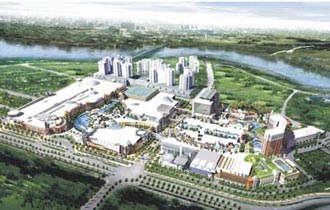World Largest Mall Struggles in China's Hooker's Capital
By wchung | 26 Oct, 2025
The New South China Mall may be the world’s largest shopping mall but it may become better known as the world’s biggest indoor ghost town unless its new owners succeed with a push to improve its abysmal occupancy rate.
The mall, located in the city of Dongguan in Guanzhou province, was completed in 2005 at a cost of 4.5 billion ($723.7 mil.). It boasts 450,000 rentable square meters (4,843,759 sq ft), 8,000 parking spaces and the infrastructure to host 2,350 retail businesses. Unfortunately, its occupancy rate is hovering around 20% though it is said to have plunged to just 1% at times, according to the Chinese-language financial news site Caijing.com.
At the moment the mall does have a few tenants, including a large AMC theater and a few US-based fast-food outlets clustered around its main entrance. But the mall’s vast empty interior has earned it the unappealing nickname “Ghost Mall” among locals.
When the mall opened on May 1, 2005 as the South China Mall it was promptly dubbed the world’s largest shopping mall based on the total value of its rental space. It was bought by Chinese PKU Resource Group, remodeled and renamed the New South China Mall in 2007.
The exact reason for the mall’s troubles are unclear. However, the city’s socio-economics may have something to do with it. Dongguan is China’s fourth largest exporter after Shenzhen, Shanghai and Suzhou. But is rapid growth into a manufacturing center has entailed massive migrations from rural regions. The vast majority of these migrants have been young women — so-called factory girls — to staff the city’s many assembly lines.
An estimated 5.5 million of the city’s 8.2 million residents are migrants. The high concentration of young, poor females has also turned it into China’s prostitution capital, with an estimated 300,000 young women plying the trade. The value of their services are estimated to account for upwards of 20% of the city’s entire service sector.
New South China Mall is holding a series of promotional campaigns in March to boost its occupancy rate to 80% from its current 20%, said Ye Jining, chief of its owner’s investment department.

New South China Mall was the world's biggest shopping mall when it was completed in 2005 and remains the world's second biggest after a mega-mall in Dubai.
Asian American Success Stories
- The 130 Most Inspiring Asian Americans of All Time
- 12 Most Brilliant Asian Americans
- Greatest Asian American War Heroes
- Asian American Digital Pioneers
- New Asian American Imagemakers
- Asian American Innovators
- The 20 Most Inspiring Asian Sports Stars
- 5 Most Daring Asian Americans
- Surprising Superstars
- TV’s Hottest Asians
- 100 Greatest Asian American Entrepreneurs
- Asian American Wonder Women
- Greatest Asian American Rags-to-Riches Stories
- Notable Asian American Professionals

